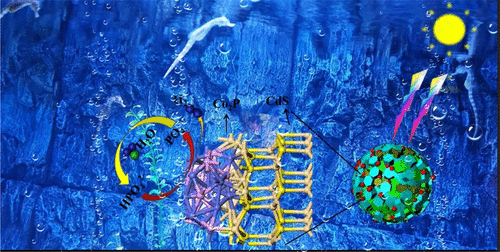当前位置:
X-MOL 学术
›
ACS Sustain. Chem. Eng.
›
论文详情
Our official English website, www.x-mol.net, welcomes your
feedback! (Note: you will need to create a separate account there.)
In Situ Synthesis of Strongly Coupled Co2P-CdS Nanohybrids: An Effective Strategy To Regulate Photocatalytic Hydrogen Evolution Activity
ACS Sustainable Chemistry & Engineering ( IF 7.1 ) Pub Date : 2018-07-02 00:00:00 , DOI: 10.1021/acssuschemeng.8b01190 Songsong Li 1, 2 , Lu Wang 1 , Shuang Liu 2 , Boran Xu 2 , Nan Xiao 2 , Yangqin Gao 2 , Weiyu Song 1 , Lei Ge 1, 2 , Jian Liu 1
ACS Sustainable Chemistry & Engineering ( IF 7.1 ) Pub Date : 2018-07-02 00:00:00 , DOI: 10.1021/acssuschemeng.8b01190 Songsong Li 1, 2 , Lu Wang 1 , Shuang Liu 2 , Boran Xu 2 , Nan Xiao 2 , Yangqin Gao 2 , Weiyu Song 1 , Lei Ge 1, 2 , Jian Liu 1
Affiliation

|
Noble-metal-free photocatalyst Co2P-CdS was synthesized via a facile in situ hydrothermal method for the first time to boost the performance of photocatalytic H2 production. This synthesis process allows the Co2P nanoparticles to disperse evenly on the surface of CdS sub-microspheres and to form unique intimate contact interfaces. The physical and photophysical properties of as-prepared Co2P-CdS composite samples were characterized by X-ray diffractometry, transmission electron microscopy, UV–vis diffusion reflectance spectroscopy, X-ray photoelectron spectroscopy, photoluminescence, and surface photovoltage (SPV) spectroscopy. The results indicate that the photocatalytic H2 evolution activity of CdS sub-microspheres under visible-light irradiation is significantly enhanced by introducing inexpensive Co2P as co-catalyst. The Co2P-CdS sample with a loading of 1.2 mol% Co2P gives the highest H2 production rate of 0.303 mmol·h–1, which was about 3 times higher than that achieved with 0.5 wt% Pt-loaded CdS sample. After further introduction of K2HPO4 as sacrificial agent, the H2 production rate reached 0.356 mmol·h–1, which is 41 times higher than that obtained with pure CdS. The apparent quantum yield of the Co2P-decorated CdS sample is about 13.88% at 420 nm. These results suggest that the synergistic effect between Co2P and CdS greatly enhances the photocatalytic activity of CdS. Moreover, a reasonable mechanism for the enhanced photocatalytic activity was proposed through density functional theory calculation and verified by SPV spectroscopy.
中文翻译:

强耦合Co 2 P-CdS纳米杂化物的原位合成:调节光催化氢逸出活性的有效策略。
首次通过简便的原位水热法合成了无贵金属的光催化剂Co 2 P-CdS,以提高光催化H 2的生产性能。该合成过程使Co 2 P纳米颗粒均匀地分散在CdS亚微球表面上,并形成独特的紧密接触界面。制备的Co 2 P-CdS复合样品的物理和光物理性质通过X射线衍射,透射电子显微镜,UV-vis扩散反射光谱,X射线光电子光谱,光致发光和表面光电压(SPV)光谱进行了表征。 。结果表明,光催化H 2通过引入廉价的Co 2 P作为助催化剂,可显着提高CdS亚微球在可见光照射下的析出活性。负载量为1.2 mol%Co 2 P的Co 2 P-CdS样品的最高H 2生成速率为0.303 mmol·h –1,这比负载0.5 wt%的CdS样品的H 2生产率高约3倍。 。进一步引入K 2 HPO 4作为牺牲剂后,H 2的生成速率达到0.356 mmol·h –1,是纯CdS的41倍。Co 2的表观量子产率P装饰的CdS样品在420 nm处约为13.88%。这些结果表明,Co 2 P和CdS之间的协同作用大大增强了CdS的光催化活性。此外,通过密度泛函理论计算,提出了提高光催化活性的合理机理,并通过SPV光谱法进行了验证。
更新日期:2018-07-02
中文翻译:

强耦合Co 2 P-CdS纳米杂化物的原位合成:调节光催化氢逸出活性的有效策略。
首次通过简便的原位水热法合成了无贵金属的光催化剂Co 2 P-CdS,以提高光催化H 2的生产性能。该合成过程使Co 2 P纳米颗粒均匀地分散在CdS亚微球表面上,并形成独特的紧密接触界面。制备的Co 2 P-CdS复合样品的物理和光物理性质通过X射线衍射,透射电子显微镜,UV-vis扩散反射光谱,X射线光电子光谱,光致发光和表面光电压(SPV)光谱进行了表征。 。结果表明,光催化H 2通过引入廉价的Co 2 P作为助催化剂,可显着提高CdS亚微球在可见光照射下的析出活性。负载量为1.2 mol%Co 2 P的Co 2 P-CdS样品的最高H 2生成速率为0.303 mmol·h –1,这比负载0.5 wt%的CdS样品的H 2生产率高约3倍。 。进一步引入K 2 HPO 4作为牺牲剂后,H 2的生成速率达到0.356 mmol·h –1,是纯CdS的41倍。Co 2的表观量子产率P装饰的CdS样品在420 nm处约为13.88%。这些结果表明,Co 2 P和CdS之间的协同作用大大增强了CdS的光催化活性。此外,通过密度泛函理论计算,提出了提高光催化活性的合理机理,并通过SPV光谱法进行了验证。











































 京公网安备 11010802027423号
京公网安备 11010802027423号